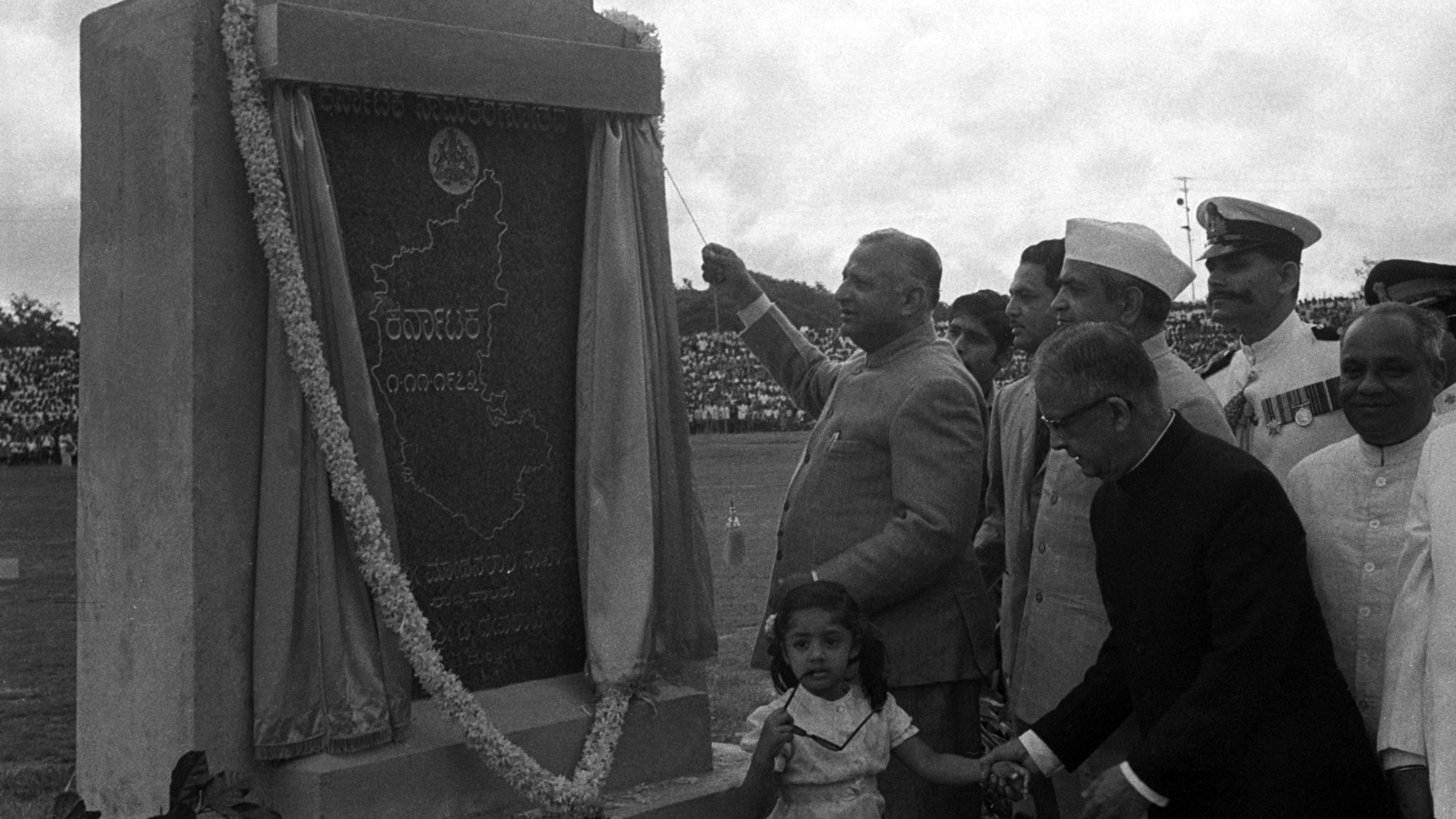
Credit: DH Photo
In 1972, when the Mysore State Legislative Assembly unanimously passed a resolution moved by the then Chief Minister Devaraj Urs to rename the state as Karnataka, there was a sense of fulfilment, of accomplishing a goal long postponed. Interestingly, Urs himself in his speech mentioned the opposition in the past to the renaming. He admitted candidly that he himself had opposed it and had argued in favour of two states, one comprising the Mysore principality and the other comprising the rest of the regions for administrative reasons. He also explained the sentiment behind the opposition as reverence for the past and the prominence of the ‘old Mysore region’. He added that he now felt that despite the persistence of some opposition, the majority of the people supported the renaming of the state as Karnataka and in the true spirit of democracy, the majority opinion has to be accepted. In his speech, there are brief references to the tardiness and lack of political will shown by previous governments.
However, the jubilation which followed the unanimous resolution in both houses of legislature elided the memories of the past. The two Houses of Parliament gave their assent on July 30 and August 8 in 1973, and the President of India signed the proclamation on October 8.
Unification movement
On November 1, Mysore, known as ‘Vishala Mysore’ after the unification in 1956 was renamed as Karnataka. Celebrations were held all over the state, especially in Hampi, an icon of the Kannada empire in popular Kannada imagination. Alur Venkata Rao, known as the arch priest (kula purohita) of the unification movement had begun his lifetime endeavour at Hampi, by mourning the loss of Kannada land with the collapse of Vijayanagara empire.
The unification movement was essentially a literary and cultural movement, but had its origin in the historical realities of the Kannada community scattered over 20 fragments, which were parts of the Nizam’s Hyderabad principality, the Mysore principality, two British presidencies and several minor principalities. The partly nostalgic, emotionally charged visionary movement soon gathered political support and people’s participation.
Apart from the sentiments of marginalisation and domination by other linguistic communities in these fragments leading to the loss of identity, there were pragmatic considerations of being deprived of the benefits of education and employment which colonial modernity had ushered in. The construction of the great Kannada literary tradition and the magnificent history of achievements of the Kannada emperors and royal dynasties energised Kannada sub-nationalism.
Interestingly, several British scholars, administrators and western missionaries had contributed greatly towards the formation of Kannada consciousness and identity in the colonial period. The political support came from Gandhi,who had always favoured linguistic provinces. The formation of the Karnataka Pradesh Congress Committee (KPCC) at the National Congress Conference at Belagavi in 1924 was seen as the symbolic political approval of the aspirations of the Kannada people for a linguistic state.
Kannada renaissance
The unification movement lasted for over 60 years and converged with the Kannada renaissance (the Navodaya literary movement) and the freedom movement. After the many convoluted political moves and countermoves in the post-Independence period, Nehru’s reluctance to establish linguistic states because they would encourage fissiparous tendencies, several commissions and growing frustration, Mysore State came into existence on November 1, 1956. Alur Venkata Rao wished progress and prosperity to “the now wrongly named State”!
The author of the secular, inclusive democratic idea of ‘Karnatakatwa’ (the essence of Karnataka) had every reason to make this statement. From the inception of the unification movement, the name of the imagined state had always been Karnataka. In all the appeals made to the British government and the commissions, as well as in the thousands of poems and songs composed during the movement, it had been Karnataka.
The justification was that the oldest references to the region, including those in the Mahabharatha had named it so. Emperors and dynasties of the land had proudly declared themselves as the rulers of Karnataka. More importantly, there was the realisation that despite the fame and status of Mysore, the imagined state had to be more inclusive, comprising several regions which were different in every aspect, including economy, culture and political experience.
As historians have pointed out, it was only in the later phase of the movement that voices were raised in favour of Mysore as the name of the state. These were accompanied by demands for two states. The fear openly expressed by the leaders of the old Mysore region was that the other Kannada regions to be amalgamated into the new state were economically backward and would be a drain on the prosperous, progressive Mysore region. In a remarkable speech, Shanthaveri Gopalagowda had condemned the narrow, undemocratic arguments of this kind. Though not publicly articulated, there was the hard political calculation that a unified Karnataka would also tilt political power towards another dominant caste. Thankfully, after much delay, unanimity emerged and the state was renamed as Karnataka.
What needs to be celebrated is the participation of the Kannada community from all regions, castes and classes, and the assertion of the political will to form a linguistic state as a member of the federal union envisaged in the Constitution. Despite some aberrations, Karnataka has retained its tolerant, secular nature, avoiding linguistic chauvinism. “In dreams begin responsibilities”, said W B Yeats. The responsibility is to preserve what Kavirajamarga, the first extant Kannada work of poetics prescribed to the Kannada community — “Isn’t it golden to tolerate well/Other religions and thoughts”.
Credit: DH Photo
People celebrate Karnataka Rajyotsava outside the Vidhana Soudha in 1973.
Credit: DH Photo